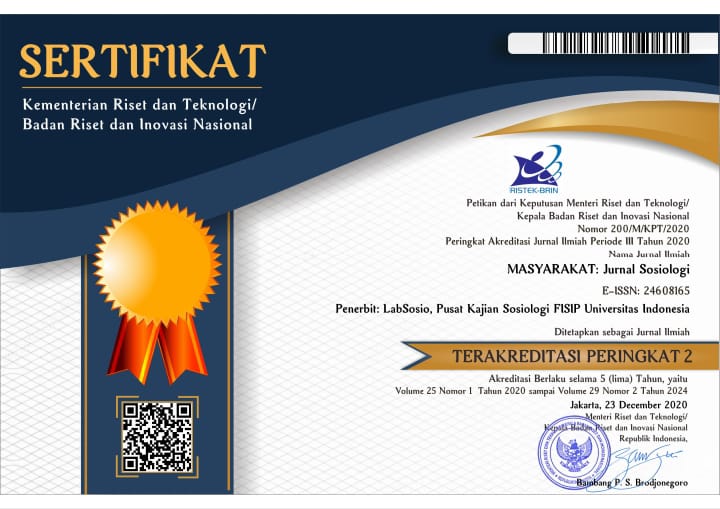Abstract
Nowadays, the people still underestimate local fashion product. Moreover, many international brand’s stores seem to dominate the market. Then, Brightspot Market comes up with the curated market concept to accommodate and promote a premium quality of local fashion product. This Article discusses representation process to youth identity in Brightspot Market event. This article discusses the representation process of youth identity to enrich the study of cultural sociology, especially the concept of “circuit of culture” by Stuart Hall. This article describes Brightspot Market which modifies circuit of culture concept. Using qualitative methods by interview and observation towards Brightspot owners, local products’ vendor and consumer, this article shows that Brightspot Market can modify that concept by represents “the cool” identity through its curated market concept to Jakarta young people.
References
Achwan, Rochman. 2013. “Kelekatan Kelembagaan: Industri Distro Fesyen di Bandung.” MASYARAKAT: Jurnal Sosiologi 18(2):139- 160. Diunduh dari: http://journal.ui.ac.id/index.php/mjs/article/ view/3723/2963. Barnard, Malcolm. 2004. Fesyen sebagai Komunikasi: Cara mengkomunikasikan identitas sosial, seksual, kelas dan gender. Bandung: Jala Pustaka. Baudrillard, Jean. 2013. Masyarakat Konsumsi. Diterjemahkan oleh Wahyunto. Bantul: Kreasi Wacana. Beng-Huat, Chua. 2005. Consumption in Asia: Lifestyle and Identities. London: Routledge. Schijndel, Hannah van dan Cassidy, Tracy. 2011. “Youth Identity Ownership from a Fashion Marketing Perspective.” Journal of Fashion Marketing & Management 15(2):163-177. Diunduh pada 30 Oktober, 2011 DOI: 10.1108/13612021111132618 Chaney, David. 2004. Gaya Hidup: Sebuah Pengantar Komperhensif. Yogyakarta: Jala Sutra. Crane, Diane. 2000. “Fesyen and its social agendas (Class, Gender and Identity in Clothing”. Academic Jurnal. The University of Chicago Press. Hall, Stuart. 1997. Representation: Cultural Representations and Signifying Practices. London: Sage. Kawamura, Yuniya. 2005. Fesyen-ology: L An Introduction to Fesyen Studies. New York: Berg Publisher. Macionis, John J. 2008. Sociology. Edisi ke-12. New Jersey: Prentice Hall. Moleong, Lexy, J. 2008. Metodelogi Penelitian Kualitatif. Bandung: Remaja Rosdakarya. Neuman, W. Lawrence. 2006. Social Research Methods: Qualitative and Quantitative Approaches. Edisi ke-6. Boston: Pearson Education. Oklacia, Latika. 2014. “Representasi Fesyen sebagai simbol status bagi kalangan mahasiswa dari kelas sosial-ekonomi menengah atas di DKI Jakarta”. Tesis. Depok: Departemen Sosiologi, Fakultas Ilmu Sosial dan Ilmu Politik, Universitas Indonesia. Okonkwo, Uche. 2007. Luxury Fesyen Branding. Palgrave MacMilan. Palmer, Jerry dan Mo Dodson., ed. 1996. Design and Aesthetics: AReader. London: Routledge. Potter, Andrew. 2009. Radikal itu Menjual: Budaya Perlawanan atau Budaya Pemasaran? Jakarta: Antipasti. Roostandi, Sidik. 2010. ”Ideologi dan Identitas Konsumen Factory Outlet : Studi Kasus pada Konsumen The Secret Factory Outle, Bandung”. Tesis. Depok: Program Studi Ilmu Susastra, Cultural Studies, Fakultas Ilmu pengetahuan Budaya, Universitas Indonesia Sproles, George. 1981. “Analyzing Fesyen Life Cycle: Principles and Perspectives.” Journal of Marketing 45(4):116-124. DOI: 10.2307/1251479. Summers. John. 1970. ”The Identity of Women’s Clothing fesyen Opinion Leaders.” Journal Marketing Research 7(2):78-185. DOI: 10.2307/3150106. Thompson, Craig dan Haytko Diana. 1997. “Speaking of Fesyen: Consumers Uses of Fesyen Discourses and the Appropriation of Countervaling Cultural Meaning.” Journal of Consumer Research 24(1): 15-42. DOI: 10.1086/209491. Wong, Tammy Jie Sia. 2014. “Visual Social Marketing of New Brands: An Exploratory Study of the Role of Photoblogs Foor New Fashion Brands”. Tesis. Ritsumeikan Asia Pacific University. “Pasarkan Produk Lokal, Brightspot Market Kembali Hadir.” 2013. Diakses 3 Januari 2015 (http://swa.co.id/business-strategy/pasarkanproduk-lokal-brightspot-market-kembali-hadir).
Recommended Citation
Junifer, Carolina
(2016)
"Brightspot Market sebagai Representasi Identitas “Cool” Kaum Muda di Jakarta,"
Masyarakat: Jurnal Sosiologi: Vol. 21:
No.
1, Article 6.
DOI: 10.7454/MJS.v21i1.1040
Available at:
https://scholarhub.ui.ac.id/mjs/vol21/iss1/6
Included in
Critical and Cultural Studies Commons, Development Studies Commons, Gender, Race, Sexuality, and Ethnicity in Communication Commons, Human Geography Commons, International and Area Studies Commons, Nature and Society Relations Commons, Organizational Communication Commons, Sociology Commons


